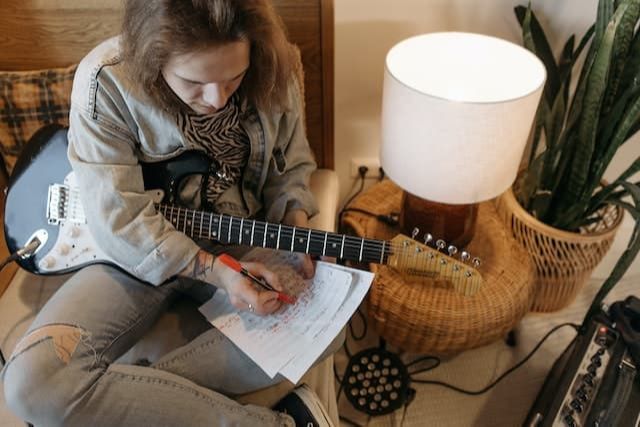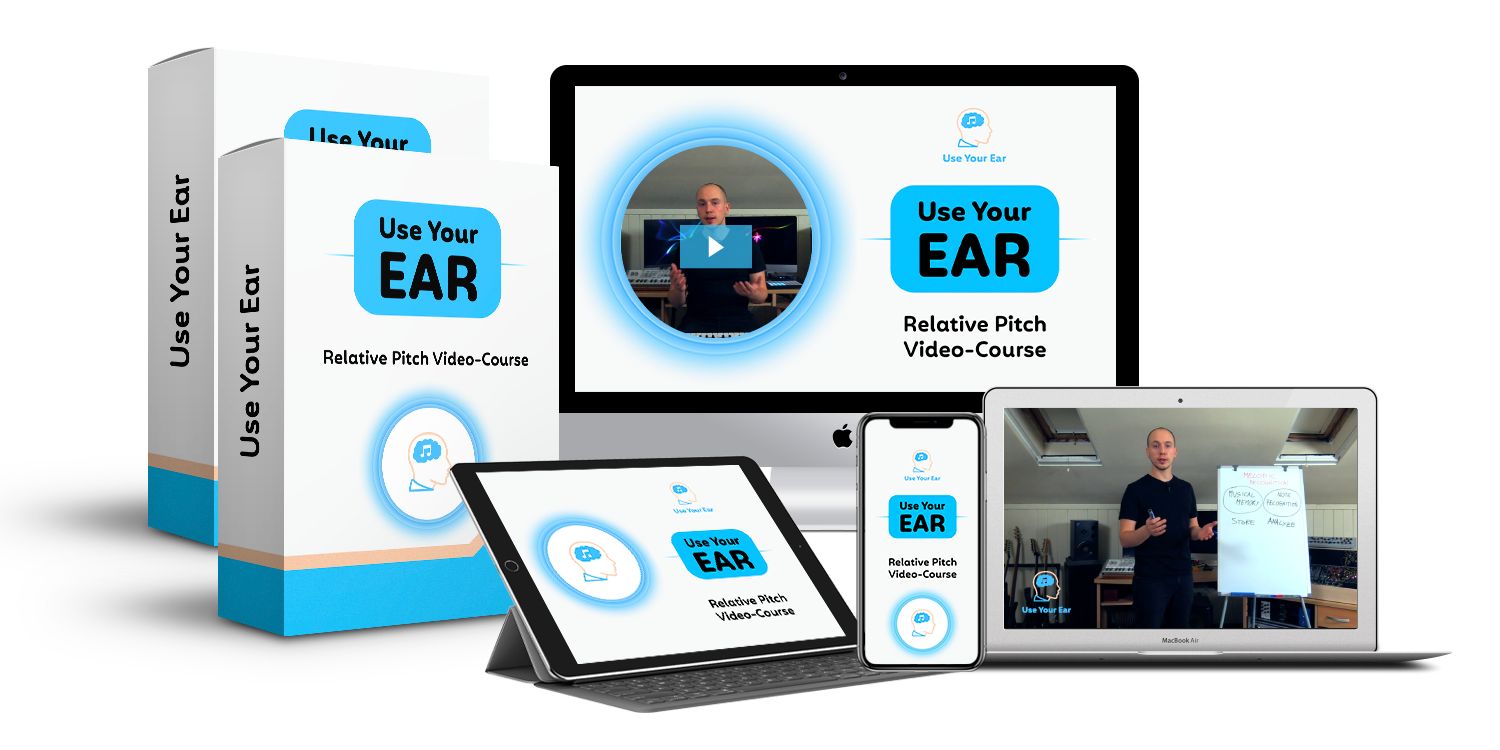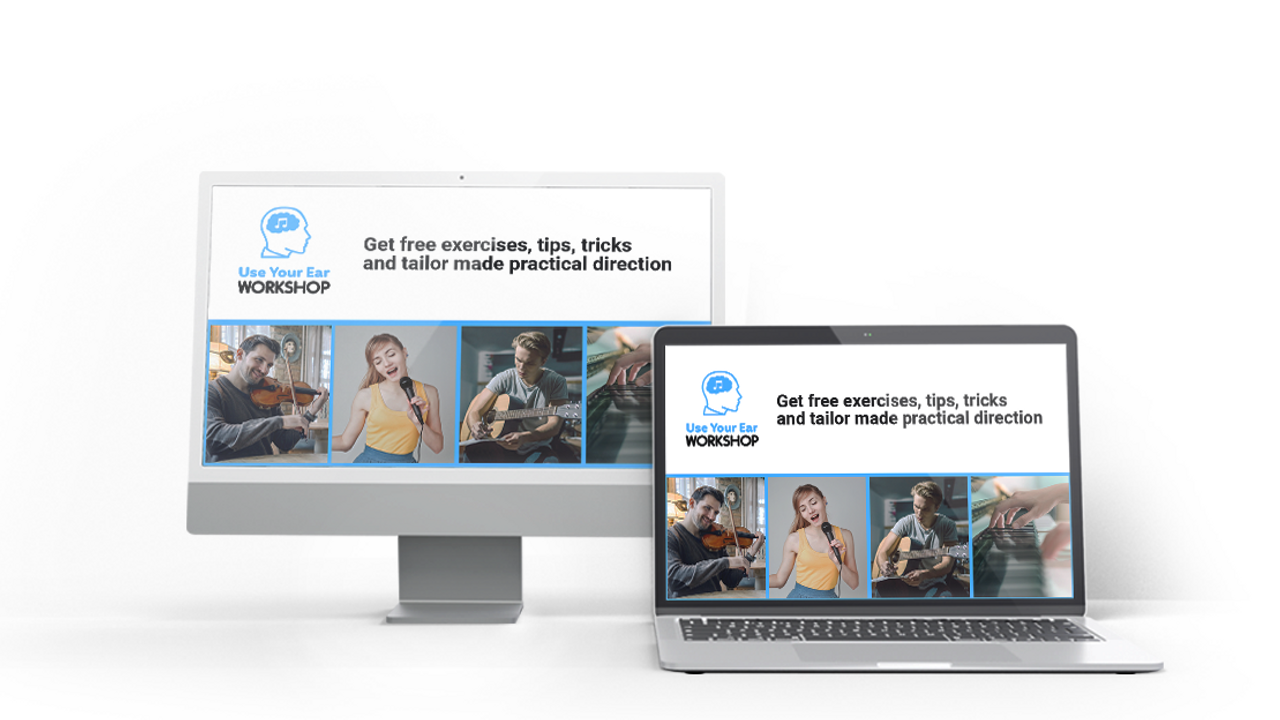Ear training for beginners
In this article, we will discuss the topic of ear training for beginners. We will also examine several interesting points such as perfect pitch, relative pitch, effective vs ineffective ear training methods, ear training exercises for beginners, and much more.
If you have just started learning an instrument such as piano, guitar, bass, drums, etc. or you love to sing, this article will show you an effective way to start your ear training journey with a purpose and strategy in place.

What is ear training?
Ear training is an area of music studies that focuses on exercises, methods, and techniques that are designed to improve our ability to recognize a variety of musical vocabulary exclusively by ear. This includes the identification of notes, melodies, intervals, chords, chord progressions, scales, and the likes.
Difference Between Perfect Pitch an Relative Pitch
Perfect pitch or absolute pitch is the ability of identifying or reproducing the exact pitch of a given sound without the need of a reference tone. People with this skill are able to identify the pitch of individual notes played on any instrument, chords, the key of a musical piece, and the sound created by everyday objects such as alarms, engines, cars honking, and so on.
According to numerous scientific studies and findings, perfect pitch can only be developed in early childhood. For these reasons, perfect pitch cannot be learned or developed at later stages in life. It is estimated that one person out of ten thousand possesses this skill.
On the other hand, relative pitch is the ability of identifying or re-creating the pitch of a given note by comparing it to a reference tone. The listener is able to recognize a given pitch in relation to a reference pitch (which commonly is the tonic of the musical key). For example, you can recognize that a given note is the 3rd degree of the major key in which the music is playing because it’s 2 scale's steps above the tonic note of the key.
Unlike perfect pitch, relative pitch can be developed at any age through ear training exercises and is an essential skill for musicians who aspire to be able to play by ear, learn songs by ear, improvise, transcribe, compose original music, and play with others. Contrary to popular belief, relative pitch skills are not related to any innate gift and are 100% within the realm of normal human abilities, like reading and writing for example.

The Importance of Ear Training for Beginners
If you are just starting out in your musical journey, your musical ear is one of the most important and valuable aspects you should aim at developing. If you are a good musician but haven’t spent time strengthening your ability to recognize different musical elements by ear, then ear training is most likely the missing link that is preventing yourself from expressing your creativity and musicality at much higher levels.
Effective vs ineffective types of ear training for beginners
One of the most important aspects of developing your ear is to choose how to tackle this process effectively by practicing the right exercises.
One of the most common mistakes made by beginners is to focus on the recognition of musical intervals as an ear training exercise. This approach requires musicians to identify the interval between two notes, without the presence of a tonal context. In other words, the pitches are played at random and do not follow a specific key or scale. The issues with the interval recognition approach can be summarized in the following five points:
- Notes, intervals, and chords convey a different auditory sensation depending on the context in which they are played;
- It doesn’t recreate real musical contexts, which are commonly based on tonality;
- It doesn’t allow you to familiarize yourself with the unique sensation each note of the scale assumes within the tonality it exists in;
- Our perception of the size of the interval is not only determined by the distance between the notes but also by their timbre. For example, the space between two notes seems larger when we increase the brightness of the higher pitch. Since there are infinite possibilities for musical timbres, we need to rely on a method that allows us to evaluate the pitch of notes and chords independently from their timbre. The interval recognition approach does not take this fundamental aspect into consideration and generates confusion in the students.
- It presents students with challenging tasks from the very beginning. This causes students to get stuck, unable to improve. It’s like trying to ask them to run without being able to walk.


Similarly, the ‘trial and error’ approach presents some issues when it comes to working with effective strategies that will ensure results. In this method, the recognition of notes/chords is achieved through the aid of an instrument.
For example, if the student is supposed to identify a note included in a melody, he or she will look for that specific pitch on their instrument by playing notes at random until they find the right one. Rather than following an intentional approach based on reliable cognitive and aural processes, they are merely searching for the notes by trial and error. Such a method will only target the student’s pitch matching skill rather than providing a system that trains the ability of truly recognizing notes and chords by ear alone. Therefore they won’t ever be able to recognize music without their instrument nor they will develop their sense of musicality by adopting such an approach

Ear training tips for beginners
The best ear training for beginners would be an approach that values the importance for students to familiarize themselves with the context of a key or tonality. Ear training for complete beginners needs to be based on tonality because our perception of pitch is dependent on the tonal context.
Rather than working with the two ineffective methods we described earlier (the interval method and the trial & error approach), it’s essential to start with an approach that is strongly based on tonality and to focus on exercises that are adequate to your current skill level.
Ear training – first steps
If you are a musician who has never tackled ear training exercises for beginners, we recommend starting with some simple exercises that are going to build a strong foundation.
Do not rely on ineffective and difficult exercises such as interval training for beginners or the ‘trial and error’ approach. You will only be left frustrated and believing that you do not have the required talent to have a great ear. Effective ear training approaches allow you to gradually develop all the sub-skills that will drastically improve your ability to figure out music by ear, no matter your age, current level, etc.
Ear training exercises for beginners
It’s important to understand that many free exercises that are found on the internet are absolutely ineffective. They are not step-by-step and will not allow you to work on the right sub-skill at the right time. This will only generate confusion, frustration, and a feeling of not being gifted with a good ear. Everyone can develop great ear training skills with the proper method in place. The following effective ear training exercises for beginners might be the right one for you. It’s important to be aware though, that ear training is a very complex topic and help from an expert teacher or method is always recommended.
Pitch matching
One great exercise for beginners is practicing your pitch matching skills, which will improve your intonation and awareness of pitch. The task is to be able to sing a particular pitch after hearing it. Simply play a note on your instrument (make sure it’s well within your vocal range) and match the pitch with your voice.

Singing the major scale
Another great beginners’ exercise is to gradually learn how to sing the major scale. Most music we hear is based on the major scale, so internalizing the sound of the major key or tonality is one of the most important short-term goals to set for yourself.
Three note dictation
Once your level of pitch matching skills and your ability to sing the major scale have improved, melodic dictation is the next gradual exercise to start working on.
In this particular melodic dictation exercise, you will hear a ‘drone chord’, which allows you to remain grounded to the tonic of the tonality and its sensation of rest and resolution.
Then, you will hear other notes that belong to the same scale - for now only the first three degrees of the scale will be played (to make it simpler). The goal of this exercise is to recognize which scale degrees have been played by using your knowledge of the major scale and your ability to determine the sonic sensation of the notes in the scale.
These are some of the initial steps towards the development of your ear training skills. There is a lot more to ear training and the following sections will uncover some important features of our approach to helping beginner students properly.

Do you want to follow the best ear training method for beginners? - We can help you
If you have just started playing an instrument such as guitar, piano, violin, etc. or you are a beginning singer, you should consider developing your ear training skills in conjunction with your instrumental practice. Music is a language and, as such, you should focus on developing your ability to identify musical vocabulary by ear in the early stages of your learning curve. If you think about how you have learned your native language, you started by being able to replicate it purely by hearing it long before you learned how to write or understand concepts such as grammar, tenses, and so on. Music works in a very similar way.
At Use Your Ear we offer great ear training methods for complete beginners and for students of all levels. We have developed a unique system that allows students to improve their aural skills by learning the language of music in a much deeper and intuitive way. Our approach is based on the knowledge and insights that many scientific studies have exposed and is guaranteed to deliver results as our many students’ positive testimonials demonstrate.
Relative Pitch Video Course
At Use Your Ear, we have created a fantastic and progressive video course to develop all the skills required to reach an excellent level of relative pitch abilities. Our program consists of fourteen units, which are methodically organized to offer students a gradual and efficient pathway to success. You will have access to a huge library of exercises, pdf’s, and a total of eight hours of video lessons.
You will be guided through the process of gradually learning all the relevant sub-skills and build an incredible foundation for all the musical activities you enjoy and plan to advance in. Such sub-skills include: pitch matching, tonic recognition, tonic retention, melodic recognition, short-term musical memory, chord progressions recognition, and many more.
Relative Pitch Video-Course

Use Your Ear Free Workshop
If you are in need of some guidance and would like to have a sample of our complete relative pitch course, we have created a three hour long workshop that you can access for free. You will discover the scientific foundations of our innovative ear training method as well as gaining access to valuable and effective ear training beginner exercises. Learn the correct way to master ear training for beginners and discover what are some of the most common mistakes and ineffective approaches that are holding you back.
Free Use Your Ear WorkshopIndividual online lessons
One of the best ways to kick start your ear training journey as a beginner is to take individual online lessons with an experienced ear training teacher. By working directly with a teacher who is specialized in our ear training method, you will be able to identify the areas you need to focus on in order to make the next steps towards achieving your musical goals. One of our experienced teachers will recognize your skill level by conducting specific tests and will be able to set you in the right path. You will get more out of such a lesson than years of practicing with any ear trainer app you can find online.
One-on-one ear training lessons online
How our students learn to recognize melodies and
chords by ear in just a few months
Check out how our students go from zero to recognizing melodies and chord progressions by ear in a few months, following the Use Your Ear method. These are just some of the skills you will develop by signing up to the Use Your Ear course.
Who are our courses for?

Our courses have been designed for musicians of all levels. The strength of our program is that it offers gradual and efficient ways to develop your ear by fostering ways of thinking about ear training and music in general that will expand your musicality, intuition, confidence, and creativity.

Whether you are an ear training beginner or a more advanced student who wants to develop a more intuitive connection to music, the Use Your Ear method will get you there. Our course is designed and is equally beneficial for singers, instrumentalists, composers, and song-writers alike.





